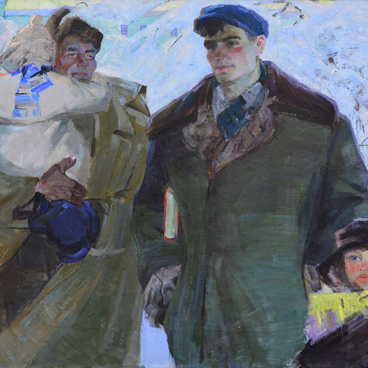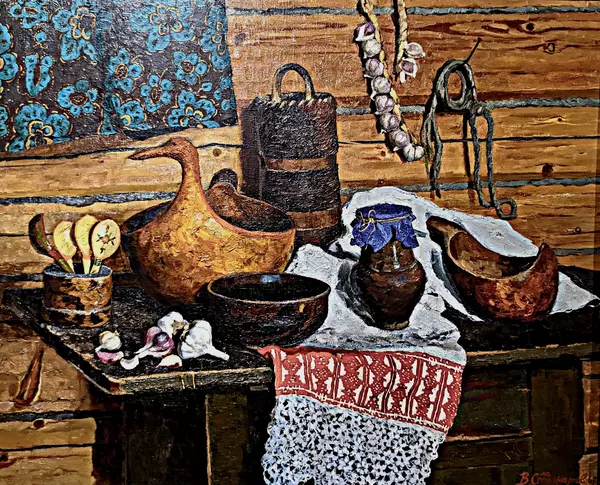Bolshaya Pyssa is a village in the Komi Republic situated by the side of the Mezen river. This unpretentious, unremarkable place appeared in Vladimir Stozharov’s paintings a number of times.
The postwar time and the following two decades in the Soviet culture were characterized by a high demand for the variety of the country’s artistic images. The special attention was paid to the themes of the Russian village, landscape painting, old Russian architecture. After all the war struggles and hardships, the common images of everyday life were especially appreciated.
It was the time when the Russian North experienced its revival in the art world. Previously it was a subject of interest between the 1880s and the 1890s, the period of ‘national’ or ‘Russian’ style in painting. However, in the 19th century it was reinterpretation of the originals in a decorative way. Art of the 20th century foregrounded the realistic beauty of this severe and mysterious land.
Vladimir Stozharov travelled a lot around the country in the 1960s. He used to bring a lot of sketches and completed works from the trips that sometimes lasted half a year. The Russian North took a special place in his art. He travelled around Vologodsk district, Archangelsk district, the Komi Republic, where he depicted a lot of small northern towns. It’s no accidence that he’s called a poet of a northern village as it became one of the main characters of his works.
‘When I work on my paintings or draw at home, I’m trying to not just depict the right house, as I know, for instance, that it’s a house where from two sons had gone to the war and didn’t return. And in that one a wife has been waiting for her man for twenty years. I want to show the beauty of those people’s souls through other images, with a picture of the houses they live in, with an image of the ground they walk, ” Vladimir Stozharov used to tell about his attitude to art.
In this painting from the museum collection the painter showed us an image of a small village Pyssa with its severe thick-walled log houses with small windows. In front of us is a stack of wood. The solid hasteless northerners’ way of living is seen through everything. Stozharov loved genre scenes that exhilarated the landscape. In this work we see two female figures in bright headcloth walking towards each other. His works don’t have any excessive details, elaborated painting or decorativeness, his style is closer to impressionistic approach. Stozharov is a recognized colourist. Colour is an identifying participant setting an image and a mood of the painting.
The postwar time and the following two decades in the Soviet culture were characterized by a high demand for the variety of the country’s artistic images. The special attention was paid to the themes of the Russian village, landscape painting, old Russian architecture. After all the war struggles and hardships, the common images of everyday life were especially appreciated.
It was the time when the Russian North experienced its revival in the art world. Previously it was a subject of interest between the 1880s and the 1890s, the period of ‘national’ or ‘Russian’ style in painting. However, in the 19th century it was reinterpretation of the originals in a decorative way. Art of the 20th century foregrounded the realistic beauty of this severe and mysterious land.
Vladimir Stozharov travelled a lot around the country in the 1960s. He used to bring a lot of sketches and completed works from the trips that sometimes lasted half a year. The Russian North took a special place in his art. He travelled around Vologodsk district, Archangelsk district, the Komi Republic, where he depicted a lot of small northern towns. It’s no accidence that he’s called a poet of a northern village as it became one of the main characters of his works.
‘When I work on my paintings or draw at home, I’m trying to not just depict the right house, as I know, for instance, that it’s a house where from two sons had gone to the war and didn’t return. And in that one a wife has been waiting for her man for twenty years. I want to show the beauty of those people’s souls through other images, with a picture of the houses they live in, with an image of the ground they walk, ” Vladimir Stozharov used to tell about his attitude to art.
In this painting from the museum collection the painter showed us an image of a small village Pyssa with its severe thick-walled log houses with small windows. In front of us is a stack of wood. The solid hasteless northerners’ way of living is seen through everything. Stozharov loved genre scenes that exhilarated the landscape. In this work we see two female figures in bright headcloth walking towards each other. His works don’t have any excessive details, elaborated painting or decorativeness, his style is closer to impressionistic approach. Stozharov is a recognized colourist. Colour is an identifying participant setting an image and a mood of the painting.









